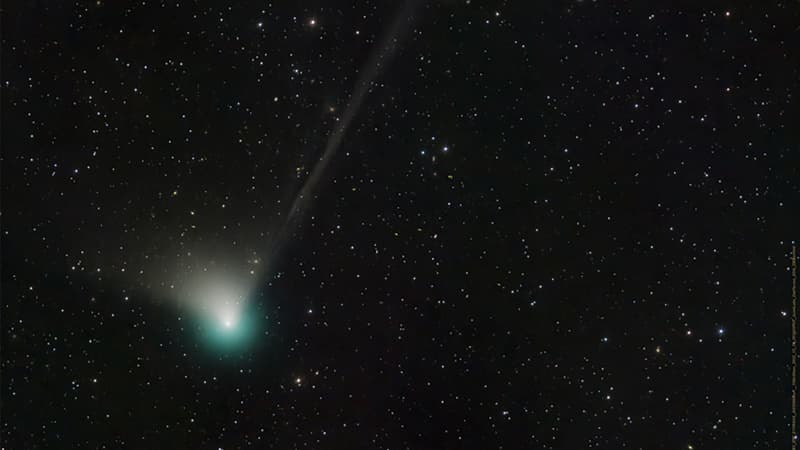50,000 years after its last pass over the heads of our ancestors, comet C/2022 E3 (ZTF) returns with much fanfare on January 12. Coming from the confines of the solar system, it knows its perihelion this Thursday, the point of its trajectory closest to the Sun, while until then it was only observable with a telescope.
C/2022 E3 (ZTF) was discovered in March 2022 by the Zwicky Transient Facility astronomical sky survey program, which operates a telescope in California. It would come from the Oort cloud, a vast group of comets, whose distance is estimated at 3.2 light years from the Sun.
Observable Thursday morning
Comets are small celestial bodies -C/2022 E3 (ZTF) has a diameter of one kilometer- formed by a nucleus of ice and dust. As they approach the Sun, the icy core of comets sublimates and lets out a long trail of dust where sunlight is reflected. It is this trail that is observable from Earth. Therefore, C/2022 E3 (ZTF) could be observed in a dark sky this Thursday night.
“The path of comets is often unpredictable. But if C/2022 E3 (ZTF) continues at its current brightness dynamics, it will be easy to see with binoculars, and it might even be possible to see it with the naked eye in a dark sky.” ” NASA wrote in late December.
The US space agency adds that stargazers in the Northern Hemisphere will be able to observe the comet early in the morning as it moves northwest during January. At the beginning of February, it will now be the inhabitants of the southern hemisphere who will have this opportunity.
“This comet is not expected to be as impressive as NEOWISE was in 2020. But it remains a unique opportunity to take on an icy visitor from a distant solar system,” continues NASA.
Mobilize your peripheral vision
Currently, C/2022 E3 (ZTF) is about 150 million kilometers from our planet. When its trajectory passes closer to the earth, “only” 43 million kilometers “will separate us from the icy object.
“You can have a nice surprise and see an object twice as bright as expected,” Nicolas Biver, an astrophysicist, told AFP. The brightness peak of comet C/2022 E3 (ZTF) could occur later, on February 1, the date on which it will be closest to Earth.
For those who wish to observe the comet, the essential condition is to find a clear sky. According to astronomers, the best shooting window will be during the weekend of January 21 and 22, as well as the following week. During this period, C/2022 E3 (ZTF) will float between the constellations of Ursa Minor and Ursa Major, before heading to the southern hemisphere and then disappearing from our human eyes forever.
The observation of the star can also be facilitated by the technique of displaced vision, continues The cross, which consists in looking not directly at the desired object but slightly to the side. More specifically, it is advisable to mobilize not the center of the retina, but its periphery to observe a celestial object. Stargazing apps or sites can also be used to observe C/2022 E3 (ZTF).
Last visit before disappearance
As its trajectory indicates, the comet could “definitely be ejected from the solar system” after passing through the sky. This latest visit could be an opportunity to better understand the composition of comets, in particular thanks to the James Webb telescope.
“We are going to observe it from all angles. It is not the comet of the century, but we are happy to be able to observe comets like these every one or two years, because we consider that they are vestiges of the formation of the solar system,” Nicolás Biver continued to AFP.
On Twitter, Éric Lagadec, an astrophysicist at the Côte d’Azur Observatory, shared a photo of the celestial object. “Admire her hair and her two tails,” he marveled. “Its short, broad dust tail and long, weak ion tail span a 2.5-degree wide field of view,” NASA added.
Source: BFM TV


